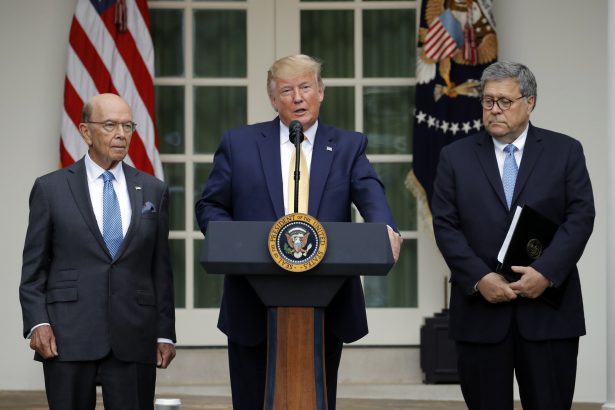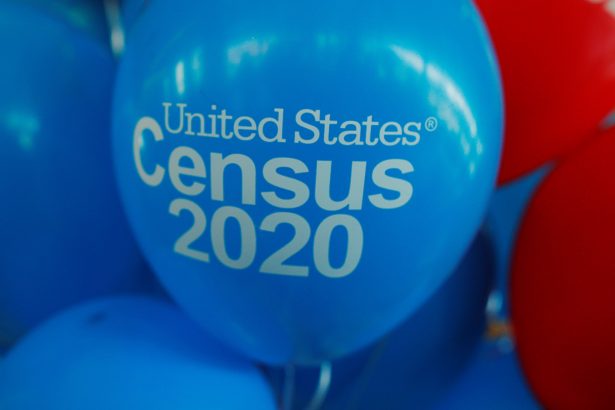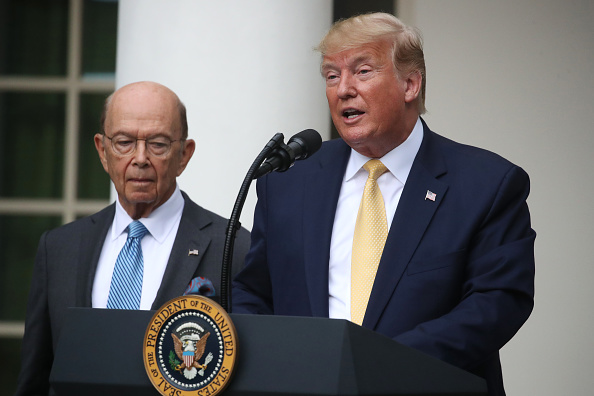인구조사에 시민권 문항을 포함시키려던 계획이 좌절된 트럼프 대통령이 새로운 방안을 내놨다. 연방기관에 시민권자와 비시민권자 통계자료를 수집하도록 하는 행정명령을 내린 것. 트럼프 대통령은 더욱 정확한 정책과 전략을 수립할 수 있을 것이라고 전망했다. 불법체류자를 인구조사에 포함시켜 지지세력을 확대하려는 민주당과 합법적인 시민권자의 권익 보호를 우선하는 트럼프 행정부가 건곤일척의 승부를 펼치고 있다. -편집부
President Donald Trump announced an executive order that will require all federal agencies to submit existing information about U.S. citizens and non-citizens to the Department of Commerce.
The Census Bureau said it could figure out the citizenship status of 90 percent or more of the population through the move, which would be more accurate than using a citizenship question on the census, Trump said on July 11.
“We will leave no stone unturned,” he said.
Trump opened the press conference with a hypothetical scenario of someone being asked if he were a citizen.

President Donald Trump is joined by Commerce Secretary Wilbur Ross and Attorney General William Barr, (R), as he speaks in the Rose Garden at the White House on July 11, 2019. (AP Photo/Carolyn Kaster=Yonhapnews Agency)
“Are you a citizen of the United States of America? ‘Oh gee, I can’t answer that question,’” Trump said.
“They’re trying to erase the existence of a very important word, a very important thing—citizenship,” he said, before alleging that people opposing accurate citizenship figures are not proud to be citizens of the United States.
“Knowing this information is vital to formulating sound public policy,” Trump added, citing health care, voting districts, and other issues.
“Unfortunately, this effort was delayed by meritless litigation,” he said. “As shocking as it may be, the far-left Democrats” want to hide the true number of illegal immigrants in the country, which is likely higher than anybody thinks, the president said.
“Today’s executive order will finally give us an accurate understanding of how many citizens and non-citizens live in our country,” Attorney General William Barr said.

Barr said the administration would have prevailed in the ongoing litigation, but the effort would jeopardize the ability to conduct the census.
“There is simply no way to litigate these issues and obtain relief from the current injunctions in time to implement any new decision without jeopardizing our ability to carry out the census itself, which we are not going to do. So, as a practical matter, the Supreme Court’s decision closed all paths to adding the question to the 2020 decennial census,” he said.
Barr also hit out at speculation that Trump was going to place the question on the census through an executive order.
“Some in the media have suggested that the administration is adding the question by executive fiat. This is based on rank speculation, and nothing more. This has never been under consideration,” he said.
The decision comes several weeks after the Supreme Court ruled that the Trump administration’s rationale for adding the question to the census “seems to have been contrived,” Chief Justice John Roberts wrote in the majority decision after the 5–4 ruling.
The rationale was that the question was needed to gather data to help enforce the Voting Rights Act.
The “explanation” was “incongruent with what the record reveals about the agency’s priorities and decision-making process,” Roberts added, The Epoch Times reported. “We cannot ignore the disconnect between the decision made and the explanation given.”
Trump has zeroed in on the issue as an example of an activist judiciary and repeatedly harangued judges who have ruled against him on the case, pointing out whether they had been appointed by President Barack Obama. He called district courts weighing different suits opposed to adding the question “unfriendly to us.”

“A very sad time for America when the Supreme Court of the United States won’t allow a question of ‘Is this person a Citizen of the United States?’” he wrote in one missive on Twitter earlier in July.
The question was on the decennial census in some form from 1820 until 1950. The question at the time was: “If foreign born, is the person naturalized?”
The president explained why he wanted the question on the census earlier this month.
“You need it for many reasons. Number one, you need it for Congress, you need it for Congress, for districting, you need it for appropriations, where are the funds going. How many people are there? Are they citizens, are they not citizens? You need it for many reasons,” Trump told reporters in Washington.
“We have a number of different avenues. We could use all of them or one. We’re doing very well on that. We’re spending $15 billion to $20 billion on a census. We’re doing everything. We’re finding out everything about everybody. Think of it: $15 billion to $20 billion, and you’re not allowed to ask them, ‘Are you a citizen?’” he said. “And by the way, if you look at the history of our country, it’s almost always been asked.”
Trump blasted critics of his citizenship question this afternoon.
"They go through houses, they ring doorbells, they talk to people. 'How many toilets do you have? How many desks? What's their roof made of?' The only thing we can't ask is "Are you a citizen..?' Pretty amazing" pic.twitter.com/3Hl1p6ScE4— POLITICO (@politico) July 11, 2019
On July 11, during the social media summit, Trump wondered anew at the logic people use to oppose the question being added.
“They go through houses, they ring doorbells, they talk to people. ‘How many toilets do you have? How many desks? How many beds? What’s their roof made of?’” he said.
“The only thing we can’t ask is ‘Are you a citizen of the United States?’ Pretty amazing.”
(원제: Trump Uses Executive Action to Count Citizens)
